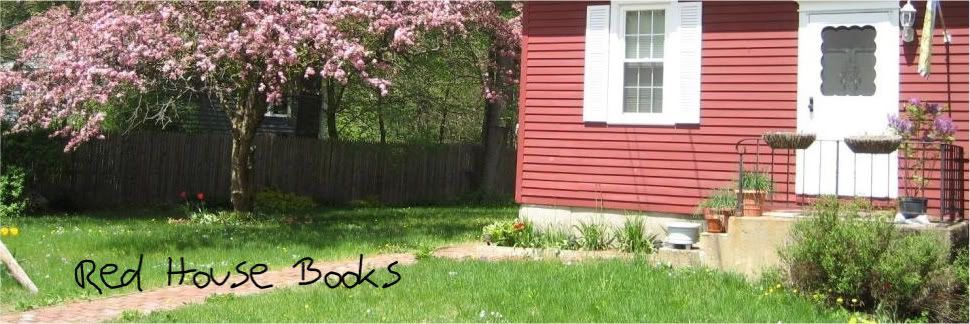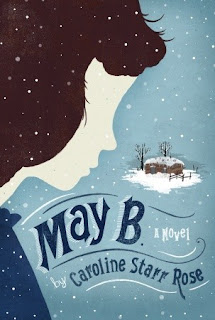A big welcome to
Caroline Starr Rose
whose debut novel
May B.
releases January 10, 2012
from Schwartz and Wade
an imprint of Random House Children's Books
I've known it since last night:
It's been too long to expect them to return.
Something's happened.
May is helping out on a neighbor's Kansas prairie homestead—just until Christmas, says Pa. She wants to contribute, but it's hard to be separated from her family by 15 long, unfamiliar miles. Then the unthinkable happens: May is abandoned. Trapped in a tiny snow-covered sod house, isolated from family and neighbors, May must prepare for the oncoming winter. While fighting to survive, May's memories of her struggles with reading at school come back to haunt her. But she's determined to find her way home again. Caroline Starr Rose's fast-paced novel, written in beautiful and riveting verse, gives readers a strong new heroine to love. (from Goodreads)
Caroline spent her childhood in the deserts of Saudi Arabia and New Mexico, camping at the Red Sea in one and eating red chile in the other. As a girl she danced ballet, raced through books by Laura Ingalls, and put on magic shows in a homemade cape. She graduated from the University of New Mexico and went on to teach both social studies and English in New Mexico, Florida, Virginia, and Louisiana. In her classroom, she worked to instill in her students a passion for books, the freedom to experiment with words, and a curiosity about the past. (from Random House)
Today Caroline share with us her thoughts on reading verse novels - something I have only just begun to do.
Reading Verse Novels
Verse novels are stories told through unrhymed poetry. It’s a format that can be intimidating to some readers, so to make the genre feel more accessible, I thought I’d try to demystify them a bit. Here are some things verse novels usually have in common:
Subject matter must be right for poetry
Some topics lend themselves more easily to poetry than others. Some subjects refuse to be written as prose. Many times an author will use verse to mimic the rhythm of the story. Here are a few books that come to mind:
• Sharon Creech’s HEARTBEAT, about a girl who loves to run
• Karen Hesse’s OUT OF THE DUST, where the spare language reflects the stark Dust Bowl setting
• Lisa Schroeder’s FAR FROM YOU, about a girl who sings and and writes songs
Protagonists must be right for poetry
Often (though not always) verse novels are told from a very close first-person point of view. Such writing calls for a lot of introspection on the protagonist's part. Other times verse is used as a way for multiple voices to be heard, almost like a Greek chorus. Here are some examples:
• Thanhha Lai’s INSIDE OUT AND BACK AGAIN, about a Vietnamese girl’s efforts to understand her new American home
• Karen Hesse’s WITNESS, where the Ku Klux Klan moves into a quiet Vermont town, and citizens reflect on the change they bring
Poems should be able stand alone
Each poem in a verse novel must capture one moment, scene, idea, mark of change in your character's life. Poems should also be able to function separately from the rest of the story.
Poems must contribute to the whole
When I worked through my own verse novel, MAY B., I kept a quilt in mind, treating each poem like its own square of fabric. Each patch had to be able to function separately while at the same time move the story forward. I trusted that if certain patterns and shades in my story quilt were repeated (think themes or story strands), eventually the interconnectedness would surface -- a much more organic approach than is normally taken with prose.
Varied poem lengths
Some scenes flow, some end abruptly. Some thoughts wander, some jab. Without the structure of chapters, verse novels are simultaneously abrupt and fluid -- poem lengths can be jagged yet aide the plot in moving through scenes swiftly. It is often difficult to find a place to stop reading, as one poem often bleeds into the next.
Varied line lengths
Verse novelists play with key phrases or words they want to bring to their reader’s attention by the way they arrange words on the page. Line breaks can be used to slow down reading, to draw the eye to important phrases, and to best "speak" the poem.
Emotion and structure
The structure of a poem often communicates to readers a character’s emotional state.
How might fear look structurally? A verse novelist might use little punctuation or words tightly packed together. Maybe the language of the poem will unfold in short bursts, reminiscent of a child peeking into a darkened room and quickly slamming the door.
Poetic form
Some verse novelists use specific types of poetry (sonnets, for example), as Pat Brisson did with her book, THE BEST AND HARDEST THING. In writing about Sylvia Plath in YOUR OWN, SLYVIA, author Stephanie Hemphill chose to mirror the format of several of Plath's poems, giving her readers a sense of the poet's style, subject matter, intensity, and character.
The visual and the aural
When I was a teacher, I used to tell my students that poetry should be seen and heard. There is something special that happens when a reader experiences seeing, hearing, and saying a poem all at once -- the fullness of the poem is discovered this way.
If you ever feel stuck with a verse novel, find a private corner and try reading it aloud.
Verse novels aren’t books with strange line breaks. They are stories best communicated through the language, rhythm, imagery and structure of poetry. Don’t be afraid to give books in this unique genre a try!
To show you some of the techniques mentioned above, I’ve included a sample poem from my verse novel, MAY B.
I play a game inside my head, (1)
counting plum trees that dot a creek bed, (2)
rabbits that scatter at the sound of wagon wheels,
clouds that skirt the sky.
For hours, that is all
and grass (3)
always grass
in different shades and textures (4)
like the braids in a rag rug.
Miss Sanders told us that lines never end,
and numbers go on forever.
Here, (5)
in short-grass country,
I understand infinity. (6)(7)
(1) Much of the story is told through thought, not dialogue. We have a real sense of May’s internal life.
(2) Verse allows for the opportunity to play with language. Here’s a bit of rhyme.
(3) Repetition for emphasis. The line break here also slows down the reader, emphasizing the miles of grass.
(4) Poetry should be visual and figurative language fresh, even unexpected.
(5) Line break for emphasis
(6) The two stanzas mirror each other in appearance, reinforcing the visual aspect of experiencing poetry.
(7) Notice the poem is about place and uses measurements/counting as a way to make sense of things. The few trees and rabbits are a contrast to infinity. The poem fits into the overall story -- May leaving for a new place -- but can also stand alone as a poem about the short-grass Kansas prairie.
Thank you so much Caroline!
As a special treat for those of you reading this today, I have some lovely May B. swag to giveaway :)
Fill out THIS FORM to enter
(ends January 18, 2012 at 11:59pm EST / open to everyone 18 years or older)
Please only enter if you have actually read this post :)
****************************************************************************
If you are a 2012 debut author of a middle grade or young adult book and would like to be featured at Red House Books this year, LET ME KNOW!




I've only started reading books in verse in the last couple of years, but so appreciate what goes into them. Thanks for this very in-depth look at the process, Caroline! I loved MAY B. and can't wait to see it in stores!
ReplyDeleteO this sounds good. I'm adding it to my TBR.
ReplyDeleteThis post is utterly awesome. I fell in love with novels-in-verse last year. The best one did exactly what Caroline said. I am going to bookmark this one. Great advice!
ReplyDelete